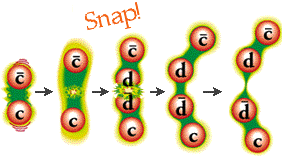fundamental? The modern atom model The scale of the atom What are we looking for? The standard model The standard model quiz
|
Quark confinement
Color-charged particles cannot be found individually. For this reason, the color-charged quarks are confined in groups (hadrons) with other quarks. These composites are color neutral.
The development of the Standard Model's theory of the strong
interactions reflected evidence that quarks combine only into
baryons (three quark objects), and mesons (quark-antiquark objects),
but not, for example, four-quark objects. Now we understand that only
baryons (three different colors) and mesons (color and anticolor) are color-neutral.
Particles such as ud or uddd that
cannot be combined into color-neutral states are never observed.
Color-Force FieldThe quarks in a given hadron madly exchange gluons. For this reason, physicists talk about the color-force field which consists of the gluons holding the bunch of quarks together. If one of the quarks in a given hadron is pulled away from its neighbors, the color-force field "stretches" between that quark and its neighbors. In so doing, more and more energy is added to the color-force field as the quarks are pulled apart. At some point, it is energetically cheaper for the color-force field to "snap" into a new quark-antiquark pair. In so doing, energy is conserved because the energy of the color-force field is converted into the mass of the new quarks, and the color-force field can "relax" back to an unstretched state.

Quarks cannot exist individually because the color force increases as they are pulled apart. |






















